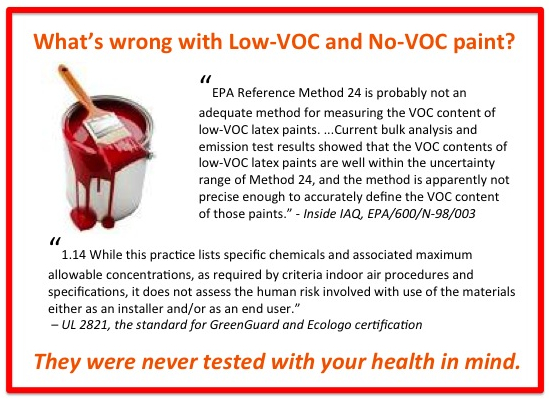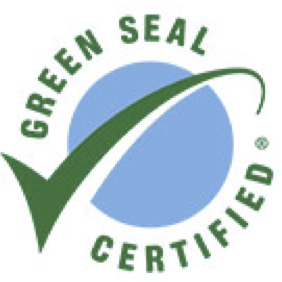There is no easier or better place to shift away from toxic petrochemicals and move to using natural, non-toxic options than with the paint we put on our walls.
Anybody Can (and Should) Do This
We hear from many people who wish they could build a home with natural materials, but because they live in an existing home they seem to feel there is no way for them to use natural materials. But using natural paints is something that anybody can do, at any time, in any home, and on any wall surface. And the benefits are profound. In terms of your family’s health, it can be better to have a non-natural home painted with natural finishes than to have a natural home painted with toxic petrochemicals. Natural paints are also better for the planet.
Why Not Just Use No-VOC Paint?
By all appearances, the paint industry seems to be getting “greener.” So why not just choose a good no-VOC paint and use that? Turns out, there are quite a few reasons. Firstly, paints labelled as “Low-VOC” or “No-VOC” are far from being non-toxic. Secondly, the petrochemical paint industry has a huge environmental and carbon footprint.
The Dirty Secret About No-VOC Paint
The impetus to reduce the quantities of volatile organic compounds (VOCs) from paints actually had nothing to do with human health concerns. VOC reductions were imposed on the paint industry because they contributed to smog, and only those VOCs that directly contribute to low-level ozone production are covered by these regulations. The US Environmental Protection Agency (EPA), the body that first imposed VOC restrictions, has this to say after testing a range of paints that qualify as low-VOC and finding surprisingly high concentrations of VOCs:
“EPA Reference Method 24 is probably not an adequate method for measuring the VOC content of low-VOC latex paints. …Current bulk analysis and emission test results showed that the VOC contents of low-VOC latex paints are well within the uncertainty range of Method 24, and the method is apparently not precise enough to accurately define the VOC content of those paints.” –Inside IAQ EPA/600/N-98/003
What If It’s Labelled as “Green”
There are some labelling programs that do ensure acrylic (commonly called “latex”) paints are less harmful to occupants. However, the most common labels do not. GreenGuard and Ecologo are the labels most commonly seen in paint stores. They are administered by Underwriters’ Laboratories (UL). Here’s what that standard has to say about its commitment to human health:
“1.14 While this practice lists specific chemicals and associated maximum allowable concentrations, as required by criteria indoor air procedures and specifications, it does not assess the human risk involved with use of the materials either as an installer and/or as an end user.” –UL 2821
 If you want to trust a label, find paints certified by GreenSeal GS-11. This is the only standard I can find that actually excludes a wide range of toxic chemicals and has a direct concern for human health.
If you want to trust a label, find paints certified by GreenSeal GS-11. This is the only standard I can find that actually excludes a wide range of toxic chemicals and has a direct concern for human health.
And Even If It’s Got a Good Green Label…
Despite the fact that they are called “water-based,” all acrylic paints are made from petrochemicals. Coatings consumption worldwide reached 80 billion pounds and $120 billion in value in 2013, according to “Global Paint & Coatings, 2013-2018,” by polymer and chemical market researchers Kusumgar, Nerlfi & Growney. That means that our use of petrochemical paint carries with it the same environmental impacts as any use of crude oil. Don’t like offshore drilling, oil sands, pipelines, greenhouse gas emissions, oil spills, etc? Every time we use acrylic paint, we contribute to all those impacts.
The embodied energy and embodied carbon emissions of acrylic paint are also very high. Using data from the Inventory of Carbon and Energy V2.0, the paint needed to coat the interior of a typical 2,000 square foot home (primer and two coats of finish) would use about 7,300 megajoules (MJ) of energy to produce, and emit 303 kg of carbon dioxides (or equivalents). That’s the energy in 1.5 barrels of crude oil or 61 gallons of gasoline required to paint every home, and somewhere in the neighbourhood of the same weight in CO2 emissions as the combined weights of the home’s inhabitants!
Now the Good News!
Don’t want to inhale toxic chemicals or contribute to oil spills and climate change? The good news is that there are plenty of accessible, affordable and practical paint options available that are non-toxic and low-impact. Most of the paint manufacturers listed here provide full disclosure of their ingredient lists, meaning that there are no hidden toxins. All have been recommended by people with chemical sensitivities.
Natural paints come in a number of different categories, based on the type of binder they use, and each type of paint has a range of different surfaces it may be used on:
Natural Oil Paints
- Drying oils (linseed, sunflower, tung, etc) polymerize when exposed to air
- Some natural oil paints are emulsified with water
- Indoor & outdoor use
- Used on almost any substrate
Although many people will have an initial negative reaction to the idea of “oil paints,” these bad associations are from very toxic petrochemical oil paints. Natural oil paints are a whole different breed. The emulsified oil paints are the most straightforward natural paints to use, and give results that are consistent with modern petrochemical paints. Washable, durable and tinted to any available colours, these paints can be used to replace conventional acrylic and alkyd paints with no change to expectations about application, coverage and durability. All the brands we’ve used are non-toxic and fully bio-degradable. Most can be obtained in just about any imaginable tint.
Auro Wall Paint, available in Canada from Tockay
Allback Linseed Oil Paint available in Canada from Living Rooms
AFM Safecoat Naturals available in Canada from Living Rooms
Kreidezeit Wall Paint, available in Canada from Tockay
Lime Paints
- Calcium carbonate binder, often with additional natural binders
- Indoor use (outdoor use for lime washes)
- Most wall substrates, surface prep may be req’d
Lime paints have been used for thousands of years, and the modern versions are excellent products that can be used on most wall surfaces. Naturally anti-septic, these paints come in a variety of textures from quite smooth to quite grainy. They add a depth and beauty that is hard to explain but is immediately obvious upon seeing them. They are durable and do not wash away with water. They are an excellent choice for any wall that receives light to heavy contact, and are available in a wide range of colours.
Kreidezeit Lime Paint, available in Canada from Tockay
Auro Lime Paint, available in Canada from Tockay
Clay Paints
- Natural clay binder, often with additional natural binders
- Indoor use only
- Most wall substrates, surface prep may be req’d
Clay paints are the champions of low-impact and low-toxicity. The fact that they are gorgeous to look at is an additional bonus! A variety of grain sizes and tints are available. They are durable (no dusting, will not brush off the wall) but are not washable. They can handle some direct wetting, but will wash off with scrubbing or constant abrasion. Good for use on any wall that does not receive direct wetting or a lot of touching/contact.
Kreidezeit Clay Paint, available in Canada from Tockay
Casein Paints
- Milk or vegetable casein binder, often with additional natural binders
- Indoor use only
- Most wall substrates, wood
Casein paints can be made from vegetable or milk casein. Similar to the clay paints, they are capable of dealing with some wetting and abrasion, but shouldn’t be used in places where this will happen consistently. A wide variety of tints are available. They can be used on walls, and also on raw wood.
Homestead House Milk Paint, available from Homestead House
Kreidezeit Vegetable Casein Paint, available from Tockay
Mineral Paints
- Potassium or sodium silicate (“waterglass”)
- Indoor & outdoor use
- Mineral substrates only (plaster, brick, concrete, etc)
Silicate dispersion paints are unique in that they don’t coat a surface, they mineralize onto the mineral surface and become an integral part of the surface. This makes them extremely durable. We use them a lot as a finish for exterior plasters, where they have the Goretex-like effect of protecting walls from bulk water penetration, but maintain the permeability of the plaster. They can be used indoors or outdoors on any surface that is mineral-based, including clay & lime plasters, concrete, brick, stucco and stone. They come in a wide range of colours, and colour matching is available.
Eco-House Silicate Dispersion Paint, available in Canada from Perma-Tint
Non-toxic Clean-up
One of the unsung benefits of using any of these paints is that they are all biodegradable. Even the “cleanest” conventional paints have a petrochemical base that ends up in waterways or in soil during cleanup, with an aggregate of thousands of gallons entering the ecosystem annually. Natural paints clean easily and the wash water can safely go into septic systems or onto the ground.
So Many Viable Options
All of the paints listed here are products that we have used with excellent results. Each type of paint has specific uses and surfaces, meaning there is no surface in or on a home that cannot be treated with a natural paint. Costs tend to be slightly higher than mid-range conventional paints, and in line with higher-end conventional options. None of these paints are unaffordable, and the slight extra cost is a small price to pay to be surrounded by non-toxic surfaces that are not off-gassing into your home, and did not have a deep impact on the environment. A worthy investment for any home!
Want to Try These Paints?
Endeavour’s Eco-Paints workshop is a day long opportunity to learn all about natural paints, and to actually use all of the paints mentioned above.









